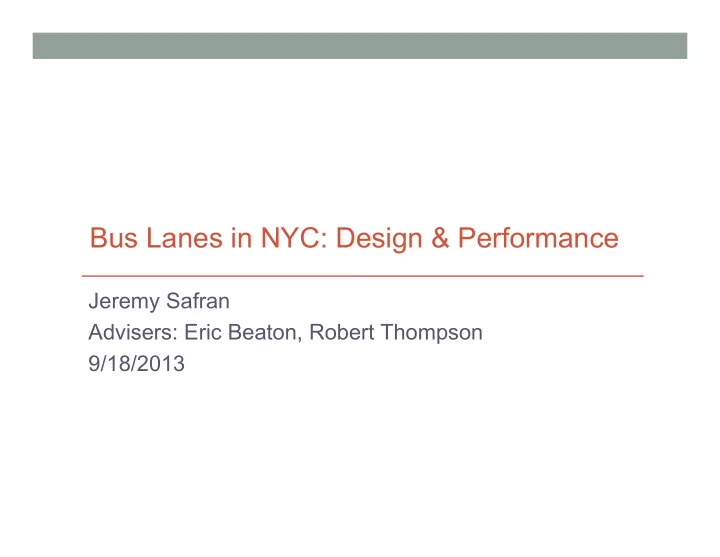

Bus Lanes in NYC: Design & Performance Jeremy Safran Advisers: Eric Beaton, Robert Thompson 9/18/2013
What they aren’t (yet) Cleveland Curitiba Guangzhou
What they are Bus lanes in NYC are permeable surfaces, which may be used or not used by bus drivers, and obstructed or unobstructed by other vehicles.
Purpose & Methodology • Study seeks to quantitatively assess the impact of bus lane design features on bus lane effectiveness across different traffic conditions. • Tests effects of lane configuration and markings color on bus lane obstruction, usage, and bus speed. • Two Studies: • Bus Lane Obstruction and Usage Study • Bus Speed Study
STUDY 1 Bus Lane Obstruction and Usage
Variables & Hypotheses Dependent Variables • Obstruction (binary) • Usage (ordinal: none, some, full) Independent Variables • Lane Configuration • Markings Color • Vehicular Volume • Pedestrian Volume • Bus Type • Taxi Presence Hypotheses • Offset & red-painted lanes will be obstructed less and used more.
Field Coding Process Example of field observation coding • (a) Left, Curbside red bus lane segment on Archer Avenue between 160th St. & Union Hall St. was observed on 11/29/2012 to have a medium level of vehicular volume, a low level of pedestrian volume, and no taxi presence. • (b) Right, A Q83 local bus fully using the bus lane, and facing no obstruction.
Design and Traffic Variable Distribution
Obstruction Findings - Descriptive
Obstruction Findings - Regression Predictor Variable Category Odds Ratio P value Low 1 -- Pedestrian Volume Medium 2.54 .000* High 7.75 .000* No 1 -- Taxi Presence Yes 1.36 .032* Local 0.92 .701 Limited 1.13 .655 Bus Type Select 1 -- Express 0.93 .794 Curbside 1.39 .049* Lane Configuration Offset 1 -- White 1.07 .642 Markings Color Red 1 -- • The obstruction model was found to be statistically significant (N= 1699, df= 8, χ 2 = 261.443, p= .000), explaining 19.1% of the variation in obstruction (Nagelkerke’s R). • Buses passing curbside segments were 1.39 times more likely to be obstructed than buses passing offset segments (p= .049). Markings color did not significantly affect obstruction.
Usage Findings - Descriptive
Usage Findings - Regression Predictor Variable Category Odds Ratio P value No 9.21 .000* Obstruction Yes 1 -- Low 1 -- Vehicular Volume Medium 1.93 .000* High 4.42 .000* Local 2.39 .000* Limited 2.06 .004* Bus Type Select 1 -- Express 1.24 .363 Curbside 1 -- Lane Configuration Offset 1.97 .000* White 1 -- Markings Color Red 1.52 .002* • The usage model was found to be statistically significant (N= 1699, df= 8, χ 2 = 645.964, p= .000), explaining 36.2% of the variation in usage (Nagelkerke’s R). • Offset lanes were 1.97 times more likely to be used than curbside lanes (p= .000), and red-painted lanes were 1.52 times more likely to be used than white-marked lanes (p= .002).
Study 1 Conclusions • Traffic variables had their expected large effects on bus lane obstruction and usage. • Irrespective of traffic effects, offset configuration significantly decreased obstruction and increased usage, while red paint significantly increased usage. • Obstruction and usage are measuring roughly the same thing on different geographic scales. Usage can be seen as a multi-segment measure of obstruction, whereby both design and environmental variables that may have discouraged obstruction on previous blocks then pay dividends in the form of usage downstream on the observed block • Better-designed lanes are less likely to be obstructed and more likely to be used, increasing the likelihood of conferring actual performance benefits to buses.
STUDY 2 Impact of Bus Lanes on Bus Speed
Variables & Hypotheses Dependent Variables • Bus travel time – (# of stops * dwell time) = non-dwell travel time • Distance/non-dwell travel time = non- dwell bus speed • Non-dwell bus speed / general traffic speed = non-dwell bus speed ratio Independent Variables • Lane Configuration, Markings Color, Traffic Hypotheses • Offset & red-painted lanes will show larger non-dwell bus speed ratios.
3 rd Avenue 7 th Avenue Upper Midtown Corridors 5 th Avenue 1 st Avenue Madison Avenue
Data Sources Taxi GPS (Traffic Speed) Schedules (Bus Speed) Cameras (Bus Speed) Fieldwork (Dwell Time) Midtown-in-Motion (Traffic Speed)
Time-Lapse Observations
Bus Speed Ratio Findings 1 Curbside White Curbside White Double White No Lane Curbside Red • The prevailing trend is that as general traffic speed decreases, non- dwell bus speed ratio increases, indicating that buses moved faster relative to general traffic when general traffic was slower.
Bus Speed Ratio Findings 2 • Different stretches occupy different regions along the curve, and by definition, wouldn’t be expected to have similar bus speed ratios • 5 th Avenue has slower traffic speeds, and therefore has higher bus speed ratios. • To compare corridors with different bus lane designs, similar ranges of general traffic speeds should be captured, and the slopes of those curves could be compared.
Study 2 Conclusions • The slower the traffic speed, the faster buses travel relative to general traffic (higher non-dwell bus speed ratios). • This traffic effect subsumed the effect of bus lane presence/design in this study because the range of sampled traffic speeds across corridors was not uniform. • Larger sample size is needed with more days of observation • The question we sought to answer was if traffic on 7 th Avenue (with no bus lane) is going 5 MPH and traffic on Madison Avenue (with double bus lanes) is going 5 MPH, which corridor has the faster bus speeds (irrespective of dwell time). Still can’t answer that yet.
THANK YOU Any questions?
Recommend
More recommend